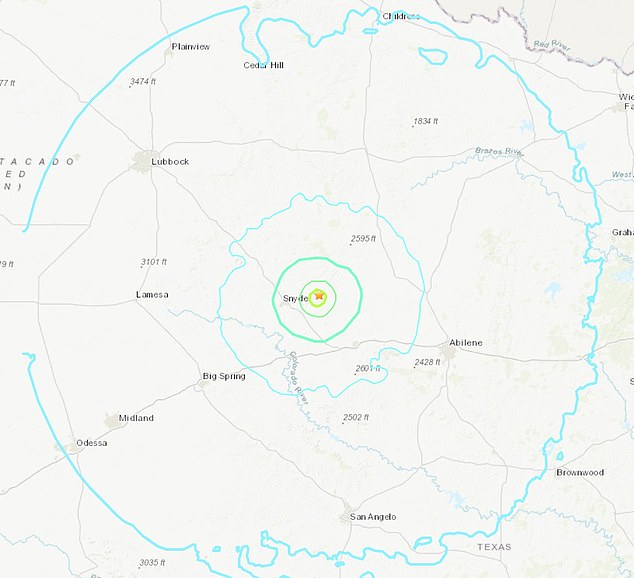
A single county has reported more than 60 earthquakes in the last week, sparking a State of Emergency to be declared.
Scurry County in West Texas was hit by a 5.1-magnitude quake on Friday, which was felt as far north as Oklahoma, followed by a 4.5-magnitude the next day.
The epicenter in Hermleigh has now experienced 62 seismic events since last Monday (July 23).
County Judge Dan hicks declared a disaster in the county Friday to get assistance from the state and is asking anyone with damage or losses to fill out a survey that will help them identify the scope of damage in the area.
Scurry County in West Texas was hit by a 5.1-magnitude quake on Friday (pictured), which was felt in Oklahoma , followed by a 4.5-magnitude the next day
The seismic events began on Monday, July 23 when reports flooded out of Texas after a 4.9-magnitude shook Hermleigh residents awake at 10:38pm CST, which was also felt in Oklahoma and New Mexico.
A 4.4-magnitude aftershock occurred less than 10 minutes after the initial earthquake and residents experienced a 3.1-magnitude in the early hours of Tuesday morning.
Hermleigh experienced another 4.0-magnitude earthquake shortly before 11pm CST on Thursday and about an hour later experience a 2.5-magnitude aftershock.
Many other quakes were reported throughout the week but registered under a 3-magnitude.
At least six seismic events were reported on Friday, with the 5.1-magnitude being marked as the fifth largest ever to hit the state.
No damages or injuries have been reported.
The largest quake was felt about 80 miles away in Lubbock and across parts of the South Plains.
West Texas is not located on a major fault line, but features 250 minor ones that extents outward 1,800 miles from the Dallas-Fort Worth area.
‘You know, we’ve had [quakes] as long as I think time’s been recorded here, as long as we’ve had people here,’ Hicks told Abilene Reporter News.

The recent uptick in seismic events has led to the Railroad Commission (RRC) of Texas opening an investigation to see if they were caused by injection of fluids into the ground for the extraction of petroleum products
‘But we don’t know of any that were this intense.’
The recent uptick in seismic events has led to the Railroad Commission (RRC) of Texas opening an investigation to see if they were caused by injection of fluids into the ground for the extraction of petroleum products.
Texas is listed as the number one state for fracking, and as of February 2017, it was home to 279,615 oil and gas wells but by 2023, that number had increased to 373,133 active wells.
‘In efforts to reduce seismicity possibly caused by underground injection of produced water, several operators in the area have converted deep saltwater disposal wells to shallow saltwater disposal wells within the last year,’ the RRC wrote in a Friday statement.
Inspectors plan to investigate wells within 2.5 miles of the epicenter this week.
‘The RRC will evaluate next steps that can be taken to mitigate earthquakes,’ the state agency added.
‘We’ll continue to take measures necessary to protect the environment and residents in the area.’
The fracking process involves miners drilling deep into the earth’s surface and releasing high-pressure water that creates a small explosion to release natural gas and oil that can be used to create energy.
The action brings groundwater to the surface and when it is injected back into the ground, it puts pressure on fault lines, resulting in more earthquakes.
Researchers have reported that seismic activity in Texas has increased since 2018 and 81 percent of earthquakes with a 2.5 magnitude or greater have been recorded since 2020.
More than 200 earthquakes with a magnitude of three or greater shook Texas in 2021 alone, more than double the number recorded from the year before.
Locals have long complained about hydraulic fracturing in the region, with one person saying they were moving to central or southwest Texas to avoid the increasing number of earthquakes.
‘The damage [from fracking] is done, and now we’re just paying that price. And this is what it is,’ one resident told the Texas Tribune in 2022.